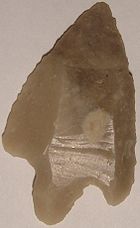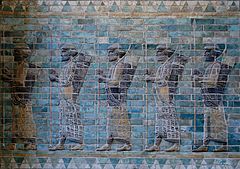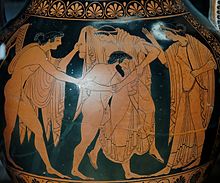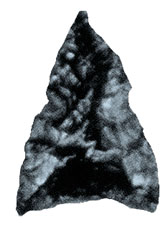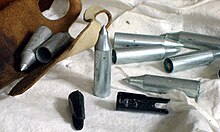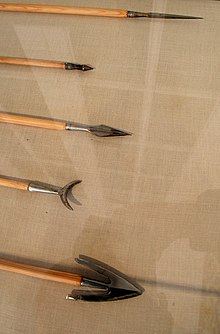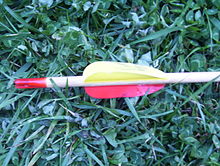Arrow
An arrow is a projectile shot from a bow. It is made up of a point (for target shooting or hunting), a shaft and a feather that is normally three feathers.
The tips can have various shapes. Target shooting points do not exceed the diameter of the arrow shaft, while hunting points do and have various shapes, from the well-known triangular shape to those that are cylindrical, used in small game.
Shaft materials can be fiberglass, wood, aluminum, carbon, or aluminum-carbon.
Feathers can be natural or plastic:
- the Natural feathers used today are turkey and come from the food industry; they are used mainly with traditional arches. They historically used goose feathers and even different birds of prey.
- the plastic feathers are used with the Olympic and compound arches.
Etymology
The word arrow has its origin in the word fliche, from Old French, which derived from flèche, which also comes from fliukka, which means the one that flies in the Frankish language. In Spanish, the form frecha was first adopted to later be called flecha, which replaced the word saeta, which came from the Latin sagitta.
History
Prehistoric era
Numerous skillfully carved flint arrowheads have been found in the oldest prehistoric sites. Already in these first specimens the triangular-shaped arrowhead appears, which has been preserved since then. The use of the bow seems to go back in Europe to a very distant time, to that of the Age of the Reindeer. In some lake station remains of wooden arches belonging to the Neolithic era have been found.
There are many types of prehistoric arrows: some are almond-shaped, others are laurel or olive leaf-shaped, others are triangular or rhomboidal. At their base they usually present a semicircle or two points. Some of these flint or rock crystal points are preserved in the National Archaeological Museum of Spain.
Ancient Egypt
The Egyptians, who, as is known, were excellent archers, used arrows with a wooden shaft and a bronze tip, generally triangular in shape. For hunting, they used arrows with wooden tips or small darts with triple flint tips attached to the shaft by means of a black shaft. Egyptian arrows had, on the opposite side, three feathers to stabilize the movement of the weapon during flight. In the surviving monuments, the warriors are presented with richly decorated quivers. War chariots always carry a quiver at their sides.
Ancient Mesopotamia
As can be seen in the Assyrian bas-reliefs, the eastern arrows were of the same type as the Egyptian ones. The tip in the shape of a laurel leaf must have been made of bronze, the shaft is quite long and has feathers attached to the end. The archers have their forearms covered with a kind of sleeve, which must have been made of leather, to prevent the rope from rubbing. Herodotus also informs us that the ancient Orientals, especially the Parthians, were very skilled in handling the arrow. It also seems that it was a terrible weapon in the hands of the Ethiopians, who did not carry a quiver, but instead placed the arrows on a kind of cap with which they covered their heads. The Scythians and the Numidians had the ability to shoot their arrows with either the right or left hand.
Greece
The Greeks were not as good arrow shooters as the Easterners. However, they must have copied the weapon from these. The Greek arrow measured about 60 cm, the shaft was made of very light wood and the metallic tip, simple or bearded, generally three-lobed. The appendage of the feathers was identical to that of the Orientals. The Greek quiver contained 12 to 20 arrows and was carried on the left side, sometimes also keeping the bow in it. Greek marksmen used to kneel on the ground, as witnessed by the monuments we know, including the pediment of the temple of Afea in Aegina. The Cretans had been reputed to be skilled in bowmanship since the time of Homer, and at a fairly advanced time in history they formed a special corps of the Greek army.
Europe
The Germans do not seem to have used the arrow except for hunting. However, the Celts and Gauls used it as a weapon of war. The Huns used leather arrows interchangeably for hunting or for war.
As for the Middle Ages, the monuments that we know serve as testimony to the use of the arrow as a weapon of prime importance among the infantry in the early days. We know that by the 12th century the archer wore two leather quivers: one for the arrows and one for the bow. The irons of the arrows were similar to those of the bolts of the crossbows; that is to say, they had two, three and even four points and rarely had barbs as in antiquity. As for the length of the shaft, it was related to the greater or lesser rigidity of the bow, as well as the height of the archer.
The famed English archers, who were said to shoot 12 arrows in a minute up to 220m, carried a bow the same height and arrows 90cm long.
Until the XIV century it seems that the irons of the arrows used in France offered a hollow part at their base to hold them to the shaft, and from that time the iron became narrower and offered four drooping points. The appearance of firearms completely banished the use of the arrow in Europe.
Rest of the world
In America, Asia, Africa and Oceania, the arrow was used since ancient times and is still used by some tribes. Arrows poisoned with plant juices or animal venoms have served as a weapon of war in America, India, and along the coasts from Arabia to China.
They were widely used for hunting and domestication of the home, as well as taming animals and then eating them.
Features
Size
The size of arrows varies widely between cultures, ranging from 45 cm to 1.5 m long. However, most modern arrows are 75 cm to 96 cm long. Arrows recovered from the Mary Rose, an English warship that sank in 1545 and whose wreckage was raised in 1982, were mostly 76 cm in length. Very short arrows have been used, shot through a guide attached to the bow (an 'overdraw') or to the archer's wrist (the 'siper' Turk). These can fly farther than heavier arrows, and an enemy without the proper equipment may find himself unable to return them.
Arrow

The arrow is the main structural element of the arrow, to which the other components are attached. Traditional arrows are made of strong, lightweight wood, bamboo, or reeds, while modern arrows can be made of aluminum, carbon fiber reinforced plastic, or a combination of materials. These rods are usually made of an aluminum core wrapped in an outer carbon fiber. A premium traditional material is Port Orford cedar.
The stiffness of the arrow is known as its spine, referring to how little the arrow bends when compressed, hence an arrow that bends less is said to have more spine. To hit consistently, a group of arrows must have a similar spine. 'Centershot' bows, in which the arrow passes through the central vertical axis of the bow riser, can achieve consistent results from arrows with a wide range of spines. However, most traditional bows are not center shot and the arrow has to deflect around the grip in the archer's paradox; such bows tend to give more consistent results with a narrower range of arrow spines allowing the arrow to deflect properly around the bow. Higher draw weight bows will generally require stiffer arrows, with more spine (less flex) to give the correct amount of flex when shot.
GPI Classification
The weight of an arrow can be expressed in GPI (grains per inch). The length of an arrow in inches multiplied by its GPI gives the arrow's weight in grains. For example, an arrow that is 30 inches long and has a GPI of 9.5 weighs 285 grams. This does not include the other elements of a finished arrow, so a complete arrow will be heavier than the arrow alone.
Arrows with foot
Sometimes the shaft is made up of two different types of wood joined together, resulting in what is known as a footed arrow. Known by some as the best of wooden arrows, footed arrows were used by both early Europeans and the indigenous peoples of the Americas. Footed arrows typically consist of a short length of hardwood near the arrowhead, with the remainder of the shaft consisting of softwood. By reinforcing the area most prone to breakage, the arrow is more likely to survive impact while maintaining overall flexibility and lighter weight.
Cannon Arrows
A fluted arrowhead is one that tapers in diameter bidirectionally. This allows the arrow to have optimal weight but still have enough strength to resist bending. Archery enthusiast Peter Dekker examined a Qing dynasty arrow shaft and found that it had the following qualities:
- Total asta length: 944 mm (37.2 plg)
- Thickness in the waist line: 8.5 mm (0.3 plg)
- Thickness at the end of the pen: 11 mm (0.4 plg)
- Thickness 530 mm (20.9 plg) from the end: 12 mm (0.5 plg)
- Thickness 300 mm (11.8 plg) from the end: 12 mm (0.5 plg)
- Thickness 218 mm (8.6 plg) from the end: 11 mm (0.4 plg)
- Thickness 78 mm (3.1 plg) from the end: 10 mm (0.4 plg)
- Thickness at the end: 9 mm (0.4 plg)
The resulting balance point of the arrow shaft was therefore 38.5% of the arrow's length from the tip. Barred arrows are considered the zenith of pre-industrial archery technology, reaching its peak design among the Ottomans.
Arrowhead
The arrowhead or projectile point is the main functional part of the arrow, and plays the largest role in determining its purpose. Some arrows may simply use a sharp point from the solid shaft, but it is much more common for separate arrowheads to be made, usually from metal, horn, or some other hard material. Arrowheads are usually separated by their function:
- The Bodkin tips are short and rigid tips with a small cross section. They were made of unhardened iron and may be used to get a better or longer flight, or for cheaper production. It has been mistakenly suggested that the interns emerged as a means of penetrating the armor, but the investigations have not found hardened Bodkin tips, so it is likely that they will be designed for the first time to expand the scope or as a cheaper and simpler alternative to the broad head. In a modern test, a direct impact of a hard steel bodkin tip penetrated the steel chain armor of Damascus. However, the archery was not effective against the armor of plates, which became available to gentlemen of quite modest means at the end of the centuryXIV.
- The "Blunts" are arrowheads without sharpening that are occasionally used for target types, to shoot tocons or other chance targets, or for smaller hunting when the goal is to shock the target without penetration. Arrow tips are usually made of metal or hard rubber. They can stun, and occasionally, the axis of the arrow can penetrate the head and target; safety is still important with the rhom arrows.
- The "joint marks" have spring cables that extend laterally from the tip. These are hooked in grass and wastes to prevent the arrow from losing in the vegetation. They are used for practice and for minor hunting.
- The "arrow marks" were used for war and are still used for hunting. Medieval tips could be steel, sometimes with hardened edges. They usually have two to four sharp blades that cause massive bleeding in the victim. Its function is to offer a wide edge to kill as quickly as possible by clearing the main blood vessels, and causing more trauma to remove them. They are expensive, damage most of the objectives and are not usually used to practice.
There are two main types of hunting heads used by hunters: fixed blades and mechanical ones. While the fixed blade head keeps its blades rigid and immovable in the head at all times, the mechanical head deploys its blades upon contact with the target, its blades opening to wound the target. The mechanical head flies better because it is more aerodynamic, but has less penetration, as it uses some of the arrow's kinetic energy to deploy its blades. However, hunters recommend mechanical heads for hunting large game such as elk, American bison etc
- Field tips they are similar to the tips of target and have a different shoulder, so that the shots failed in the exterior are not stuck in both obstacles and the tocons of the trees. They are also used for the practice of shooting by hunters, as they offer flight characteristics and weights similar to those of the shooting tips, without being stuck in the materials of the target and causing excessive damage when being withdrawn.
- Diana tips They are shaped as a bullet with a conical tip, designed to easily penetrate into the head of the target without causing them excessive damage.
- The "security arrows" are designed to be used in various forms of recreation combat, to reduce the risk when shooting people. These arrows can have very wide or padded heads, such as the big foam ball tip used in archery tag. In combination with restricted weight arches and shooting length, these heads can reduce to acceptable levels the risks of shooting arrows to conveniently armored people. The parameters will vary depending on the specific rules used and the risk levels considered acceptable to participants. For example, the combat rules of the SCA require a quilted head of at least 1+1/4 plg (3.2 cm) of diameter, with arches that do not exceed 28 inches (711.2 mm) and 50 lb (22.7 kg) of shooting for use against well armoured individuals.
Arrowheads can be attached to the shaft with a cap, a socketed tang, or inserted into a recess in the shaft and attached by a process called hafting. Capped heads simply slide snugly over the end of the shaft, or they can be attached with hot glue. Split arrow construction involves splitting the arrow shaft lengthwise, inserting the arrowhead, and securing it using a ferrule, sinew, or wire.
T-shirts
The arrowheads sit on the back of the arrow and act like airfoils to provide a small amount of force used to stabilize the arrow's flight. They are designed to keep the arrow pointing in the direction of travel by heavily damping any tendency to pitch or yaw. Some cultures, for example most of New Guinea, did not use vests on their arrows. Additionally, arrows without vests (called bare shafts) are used for training purposes, because they make arrows more visible. some goalie mistakes.
Sleeves are traditionally made from feathers (often from a goose or turkey) attached to the arrow shaft, but are now more often made of plastic (known as "vanes"). Historically, some arrows used for armor testing used copper on the vanes. Flying archers may use razor blades for chartering, in order to reduce air resistance. With conventional three-feather fletching, one feather, called a 'cock' feather, is at right angles to the nock, and is usually capped so that it does not come in contact with the bow when the arrow is fired.. The four-feather feathering is usually symmetrical, and there is no preferred orientation for the nock; this makes stringing the arrow slightly easier.
Natural feathers are usually prepared by splitting and sanding the feather before gluing it. Additionally, the feather can be trimmed to shape, die-cut, or burned with an electrically heated hot wire. It is crucial that all the feathers on an arrow have the same drag, so manual trimming is rarely used by modern fletchers. The burnt wire method is popular because it is possible to make different shapes by bending the wire, and the fletching can be trimmed symmetrically after gluing by twisting the arrow into a fixture.
Some t-shirts are dyed. Two-tone fletchings often make each shirt out of two feathers joined together. The front shirt is usually camouflaged, and the back is shiny, so that the archer can easily follow the arrow.
Artisans who make arrows by hand are known as "fletchers," a word related to the French term for arrow, flèche. Glue and thread are the traditional methods of attaching shirts. In modern times a "T-shirt template" to keep the t-shirts in the exact orientation on the pole while the glue sets.
Whenever a natural shirt is used, the feathers on any arrow must come from the same wing as the bird. The most common are the right wing feathers of the turkey. The slight fluffing of the natural feathers requires them to be strung with a right twist for the right wing, a left twist for the left wing. This rotation, through a combination of gyroscopic stabilization and increased drag at the tail of the arrow, helps the arrow fly in a straight line. Artificial helical fletches have the same effect. Most arrows will have three vests, but some have four or even more. T-shirts generally range from 2 to 6 inches (50 to 150 mm) in length; flying arrows intended to travel the maximum possible distance typically have very low vests, while broadheaded hunting arrows require long, tall vests to stabilize them against the aerodynamic effect of the head. T-shirts can also be cut in a number of different ways, the two most common being the parabolic cut (i.e. a smooth curved shape) and the shield cut (i.e. shaped like half of a very narrow shield).
In modern archery with bolt-on tips, clockwise rotation is generally preferred as it causes the tips to self-tighten. In traditional archery, some archers prefer a counterclockwise rotation because it gets the hard (and sharp) arrow feather further from the arrow rack and away from the shooter's hand.
A flu-flu is a form of shirt, usually made using long sections of full-length feathers taken from a turkey, in most cases six or more sections are used instead of the traditional three. Alternatively, two long feathers can be coiled around the end of the arrow. The additional shirt generates more resistance and slows the arrow quickly after a short distance, around 30 m (32.8 yds).
Flu-Flu arrows are often used for bird hunting, or for children's archery, and can also be used to play Flu-Flu Golf.
Wraps
Wraps are pre-cut thin sheets of material, often vinyl or plastic, used to wrap the nock end of an arrow, primarily as an aid in attaching vanes and feather fletches to the shaft. Wrappers can also make it easier to remove popsicles and popsicle glue eventually. Additionally, they add a decorative aspect to the arrow's construction, which can give archers the opportunity to customize their arrows. Brightly colored wrappers can also make arrows much easier to find in brush, and to see on targets at a distance.
Nock
The nock is the rear part of the arrow that is attached to the bowstring. In English it is common to say "nock an arrow" when preparing a shot. A nock is a notch at the butt end of an arrow. Helps keep the arrow properly spun, prevents the arrow from slipping sideways during shot or after release, and helps maximize arrow energy (i.e., range and lethality) by helping an archer place the arrow in the place of greatest movement on the bowstring. Some archers mark the position of the nock with beads, knots, or twine wrappers.
The main purpose of the nock is to control the rotation of the arrow. Arrows bend when released. If the curvature collides with the bow, the aim of the arrow will deviate. Wooden arrows have a preferred bending plane. Synthetic arrows have a designed flex plane. Normally this plane is determined by the grain of the arrow wood, or the structure of a synthetic arrow. The nock groove must rotate at a chosen angle so that when the arrow bends, it avoids or slides on the bow. This almost always means that the nock groove should be perpendicular to the grain of the wood, when viewed from behind.
The Self nocks are grooves cut into the back of the arrow. They are simple, but they can break at the bottom of the groove. Snap fasteners are often reinforced with portions of fiber glued near the bottom of the slot. The strongest nocks are separate pieces made of wood, plastic, or horn that are attached to the end of the arrow. Modern nocks, and traditional Turkish ones, are often constructed so that they curve around the string or even pinch it slightly, so that the arrow is unlikely to slip.
In ancient Arab archery "unpointed arrows" were sometimes used. When shooting at the enemies, the Arabs saw that they picked up the Arab arrows and returned them. So the Arabs developed bows with a small ring attached where the nock would normally be attached. The butt end of the arrow was tapered to a point, rather than being cut for a nock. The rear end of the arrow was inserted into the ring. The arrow could be drawn and released as usual. Thus, the enemy could pick up the arrows, but would not return them with a conventional bow. In addition, since there was no nock, it could not be broken and the arrow was less expensive. One battle tip was to have several rings attached to the bowstring in case one broke. A practical drawback compared to a nock would be to preserve the optimal rotation of the arrow, so that when it flexes it does not hit the bow. bowstave. The direction of bending of the arrow could have been indicated by its fletching.
"Some arrow materials, such as hollow shaft/bamboo/reed, lend themselves to nock insertion. Softer woods, such as pine or cedar, also required some form of reinforcement of hardwood, bone, or horn to prevent the rope from snapping its shaft when released. Hardwoods like oak and ash did not need additional reinforcement. To strengthen a nock, most often a slit was cut in the end of the arrow and a piece of harder material, the same width as the arrow, was glued into it. The arrow was then rotated 90 degrees and a shallower groove was cut for the string. When done this way, the string would actually push on the wood or bone insert instead of the softwood itself, preventing the arrow from breaking. Another method of preventing nocks from splitting was to tie the arrow between the nock and the back of the fletch with sinew and leather tail or a coarse string, such as silk, held together with adhesive, either fish glue or birch tar.."
Types
- Burning arrow. This is called the arrow that was embedded or covered with flammable mixtures and shot at the war machines and fortifications built with materials accessible from being burned.
- Burning arrow. It was very similar to the fiery arrow, with the difference that along with the iron it had an elliptical cavity in which fuel objects were placed to which fire was given at the time of shooting it. According to its size, it was fired with the catapult or hand arch. The consul Curio used the arsonist arrow against the elephants that Pirro de Epiro wore in the battle of Benevento, 276 years before our era, to encourage his legions, terrified by the stray that those quadruped did, with whose stratagem not only managed to encourage the Romans but to irritate the elephants with the wounds and the burns, completely messed up.
Arrows as symbols
Arrow figures are widely used for trajectory and direction marking in drawings, as well as traffic signs. In general, an arrow is a line that ends in a prominent point.
Astronomer Carl Sagan suggested that including an arrow in the pattern printed on the disk that was placed on the Voyager probe would indicate to intelligent extraterrestrial beings that we have a past as hunters.
Materials and manufacturing processes
With resins, the Pultrusion process is used.
Contenido relacionado
Projectile
River Plate Athletic Club
Axe


